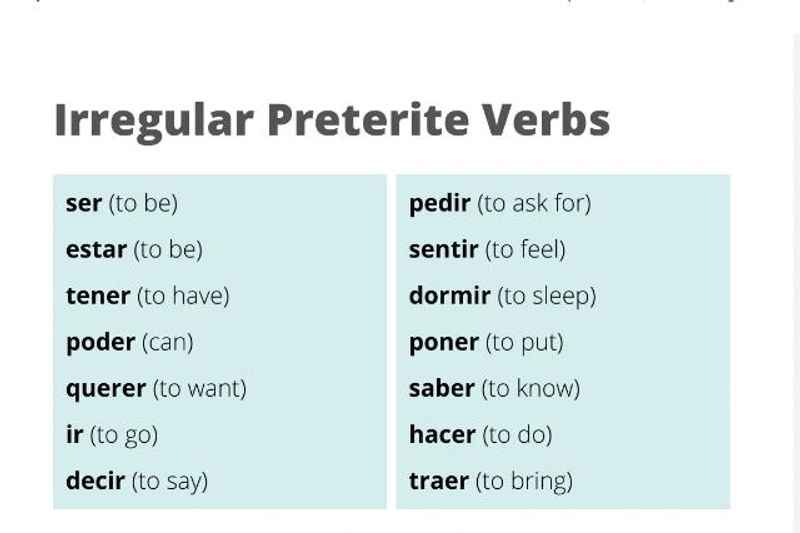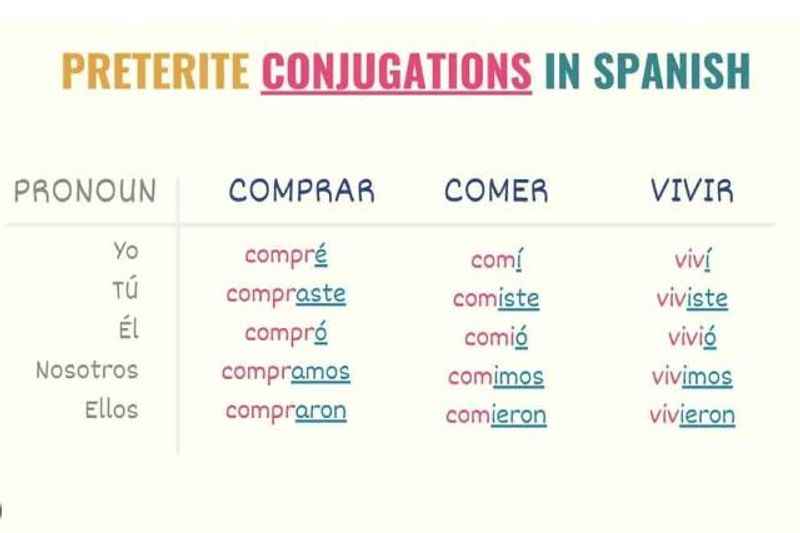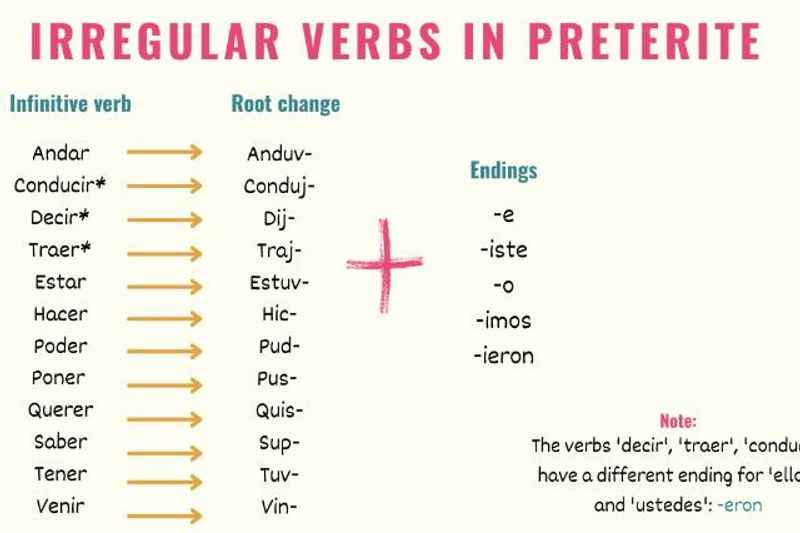Irregular Preterite Verbs in Spanish - A Complete Guide

The preterite tense in Spanish is one of the more difficult past tenses to master, even with regular verbs. Today, we take you through the list of irregular verbs in the preterite tense.
In this post, we cover the following:
- A recap of the past tense in Spanish
- How to conjugate irregular preterite verbs in Spanish
- Spanish stem-changing verbs in the preterite tense
What is the Past Tense in Spanish?

If you're studying irregular preterite verbs in Spanish, it's likely that you are already familiar with the past tense. Nevertheless, we'll begin with a quick recap, given that it's so easy to confuse the preterite and imperfect tenses.
In the indicative mood (making a statement or asking a question with the use of a verb) there are two ways to speak about the past tense. These are the preterite (also known as the simple past) tense and the imperfect tense.
The Spanish preterite tense is used to describe actions that have been carried out or completed at a specific point in the past.
For example:
Juan se fue al estadio - Juan went to the stadium
The imperfect tense is used to describe habitual or continuous actions in the past with no specific beginning or end. For example:
Juan iba al estadio - Juan used to go / was going to the stadium
It's important to know the nuances between past tenses, particularly when writing essays in Spanish. Spanish speakers are a little more forgiving with mistakes when speaking.
Make sure you learn the irregular preterite form of both ser and estar when using the past tense.
How to Conjugate Irregular Preterite Verbs in Spanish

All verbs listed in this post are irregular in one way or another. If you don't understand how to conjugate these irregular verbs then you'll find an explanation below.
However, the level of irregularity varies. Some verbs require only slight changes, whilst others undergo drastic changes. There are also several verbs, many of which are the most commonly used, which do not abide by any set of rules.
We have split these groups of irregular verbs into the following categories:
-
Verbs that undergo drastic changes: Dar,Ir, Ser, Ver, Hacer
-
Verbs that require a stem change, but use regular endings
- IR verbs that require a stem change
- Verbs ending in -ucir
- Verbs that are irregular solely in the 'yo' form
Verbs that Undergo Drastic Changes: Ser, Ir, Dar, Hacer, Ver
Ser/Ir (to be/ to go):
- Yo fui
- Tú fuiste
- Él/Ella/Usted fue
- Nosotros/Nosotras fuimos
- Vosotros/Vosotras fuisteis
- Ellos/Ellas/Ustedes fueron
Dar (to give):
- Yo di
- Tú diste
- Él/Ella/Usted dio
- Nosotros/Nosotras dimos
- Vosotros/Vosotras disteis
- Ellos/Ellas/Ustedes dieron
Hacer (to do/make):
- Yo hice
- Tú hiciste
- Él/Ella/Usted hizo
- Nosotros/Nosotras hicimos
- Vosotros/Vosotras hicisteis
- Ellos/Ellas/Ustedes hicieron
Ver (to see):
- Yo vi
- Tú viste
- Él/Ella/Usted vio
- Nosotros/Nosotras vimos
- Vosotros/Vosotras visteis
- Ellos/Ellas/Ustedes vieron
The first irregular preterite verbs in Spanish to learn are those which follow no set of rules or grammar pattern whatsoever. These verbs are the most commonly used verbs in the preterite tense in Spanish.
Ser and Ir
Note that the verbs SER and IR are identical when conjugated in the preterite tense.
This may seem strange if you are yet to use these verbs in the past tense. A relatively straightforward way to remember which verb to use in the right context is to note that the verb ir is used when something moves from one place to another.
When this is the case, it will usually require the use of prepositions such as the “a”, or “para”. However, if a location is already mentioned then the use of a preposition is not necessary.
We'll take a look at the examples below:
Fui a ver a mi amigo - I went to see my friend
Fui su amigo por muchos años - I was his friend for many years
By using these verbs a few times, or hearing them in conversation, you'll soon get used to them.
Let's continue with the other verbs which undergo drastic changes in the preterite tense.
So, you now have a list of irregular preterite tense verbs in Spanish. In order to learn them, try writing them down and put them into context using everyday scenarios. We will now move on to look at stem changing verbs in the preterite tense.
Whilst these verbs are still irregular, you should notice that they follow fixed patterns. They should, therefore, be easier for you to remember.
Spanish Verbs That Require a Stem Change
The following verbs require a stem change (meaning that the middle of the conjugated form changes) but follow the same endings. This may sound complicated, but it actually makes these verbs easier to learn in the preterite tense.
You'll notice that these endings are almost identical to regular preterite tense endings. Take a look at the next table below. All you need to do is add the endings to the following relevant stems.
Irregular Preterite Verbs Ending In -IR which require a stem change
If you have already learned how to use the simple present tense in Spanish then this will become easier for you. Stem-changing IR verbs in the simple present tense also require a change in the preterite tense.
The good news is that once the stem changes, you use the same preterite endings for all regular IR verbs.
Before we elaborate on this point, we'll review the endings for IR verbs in the preterite tense.
This should all seem relatively easy.
Remember that Spanish IR verbs that change stem in the simple present tense will also change in the preterite. However, this is only applicable for the personal pronouns: él,ella,usted,ustedes,ellos,ellas.
Changes in the Preterite Tense
Some stems see vowel changes from 'e' - to 'i' and from 'o' to 'u'
We can see some examples of these preterite tense endings below.
Pedir (to ask for) - 'e' - to 'i'
Yo pedí una cerveza - I asked for a beer
Ella pidió agua - She asked for water
Dormir (to sleep) 'o' to 'u'
Yo dormí bien - I slept well
Él durmió en el sofá - He slept on the sofa
Other Spanish Verbs That Require This Change
To have fun – Divertirse
To lie – Mentir
To prefer – Preferir
To feel – Sentir
To suggest – Sugerir
To wear/to get dressed – Vestir/se
Note: The stem change is the same even for reflexive verbs.
Irregular Preterite Verbs Ending In -UCIR
You'll know by now that there are several common Spanish verbs that end in -ucir in the infinitive form.
The verbs below require the following endings in the preterite tense:
- -uje
- -ujiste
- -ujo
- -ujimos
- -ujisteis
- -ujeron
Verbs that need these endings include:
To drive – Conducir
To produce – Producir
To translate – Traducir
To bring – Traer
To say – Decir
For example:
Yo conduje
Tú condujiste
Él/Ella/Usted condujo
Nosotros/Nosotras condujimos
Vosotros/Vosotras condujisteis
Ellos/Ellas/Ustedes condujeron
Irregular Preterite Verbs in the 'Yo' Form
Finally, in order to master your use of the preterite tense in Spanish, you'll need to learn the verbs which are irregular solely in the first person singular form.
Whilst this requires a change of spelling, the pronunciation remains the same.
There are three categories of verbs affected by this rule:
Verbs ending in -car change 'c' to 'qu'
Verbs ending in -gar change 'g' to 'gu'
Verbs ending in -zar change 'z' to 'c'
Learn Spanish Irregular Preterite Verbs
This post should have provided you with some clarity relating to irregular preterite tense verbs in Spanish. Unlike the imperfect and pluperfect tense, the preterite tense is a little tricky and will require additional practice.
Additionally, the video below should help you; it summarizes the content of this post.
Irregular Preterite Verbs in Spanish: Practice

Hace dos meses mi hermano y yo (ir) ____ a Argentina.
Anoche, mi esposa (cocinar) ____ una cena deliciosa con albóndigas.
Mi hermano (ser) ____ un buen estudiante. Siempre sacaba buenas notas en las pruebas de inglés.
Mi familia (tener) ____ abandonar sus estudios, porque eran muy caros.
Mi familia no (traer) ____ nada de comida a la fiesta.
La película (comenzar) hace una hora. (Llegar) (Tú) ____ muy tarde.
Al fin (encontrar) (yo) ____ mi celuar. Lo había dejado en la cocina.
Mi mujer me (pedir) ____ una casa nueva.
Alejandra no (traducir) el documento completo.
Hace un par de años mi hermano y yo (viajar) a España de vacaciones. (Ser) ___ un viaje genial.
Answers

Hace dos meses mi hermano y yo fuimos a Argentina.
Anoche, mi esposa cocinó una cena deliciosa con albóndigas.
Mi hermano fue un buen estudiante. Siempre sacaba buenas notas en las pruebas de inglés.
Mi familia tuvo que abandonar sus estudios, porque eran muy caros.
Mi familia no trajo nada de comida a la fiesta.
La película comenzó hace una hora. Llegaste muy tarde.
Al fin encontré mi celular. Lo había dejado en la cocina.
Mi mujer me pidió una casa nueva.
Alejandra no tradujo el documento completo.
Hace un par de años mi hermano y yo viajamos a España de vacaciones. Fue un viaje genial.
FAQs About Irregular Preterite Verbs
Now, let's look at some frequently asked questions about irregular verbs in the preterite past tense.
What are the 4 irregular verbs in preterite?
Four irregular verbs in the preterite tense are ser ("to be"), ir ("to go"), dar ("to give"), and ver ("to see"). They deviate from the regular -ar, -er, and -ir verb conjugation patterns, requiring unique forms. Despite their irregularity, these verbs are essential to master since they are frequently used in past actions.
There are many other irregular preterite verbs, some with an irregular stem, others with irregular endings, and these must be learned by memorization.
Why are there so many irregular preterite verbs?
The irregularities in preterite verbs stem from historical changes in the Spanish language. Over time, some verbs underwent phonetic or stem changes in the past tense. Irregularities can also be influenced by their Latin origins or phonological shifts. While irregular verbs add complexity, they are a testament to the richness and evolution of the language.
What is the preterite past tense?
The preterite tense, also known as the simple past tense, is used in Spanish to describe completed actions or events that happened at a specific point in the past. It is distinguished from the imperfect tense, which describes ongoing or habitual actions in the past. The preterite is formed with regular and irregular verb conjugations.
Why is preterite conjugation so hard?
Preterite conjugation can be challenging due to the numerous irregular verbs that don't follow typical patterns. Memorizing irregular forms, stem changes, and spelling variations can be overwhelming for learners.
Additionally, distinguishing between preterite and imperfect tenses requires understanding the context and nuances of past actions, making it more complex than present tense conjugations. Regular practice and exposure are key to mastering preterite conjugation.
Summing Up: Irregular Preterite Verbs in Spanish - A Complete Guide
Mastering irregular preterite verbs in Spanish is an essential step toward fluency in the language.
While these verbs may present a challenge, understanding their unique conjugation patterns and subtle nuances is crucial for effective communication in the past tense.
By categorizing the irregularities and practicing with real-life scenarios, learners can gradually build their proficiency.
The distinction between preterite and imperfect tenses may require extra attention, but continuous practice and exposure will foster greater comprehension.
Embracing the richness of irregular verbs in Spanish showcases the language's historical evolution and cultural depth, making the journey to fluency both rewarding and fulfilling.
Practice writing out conjugation endings and irregular stems to help familiarize yourself with the vowel changes.







